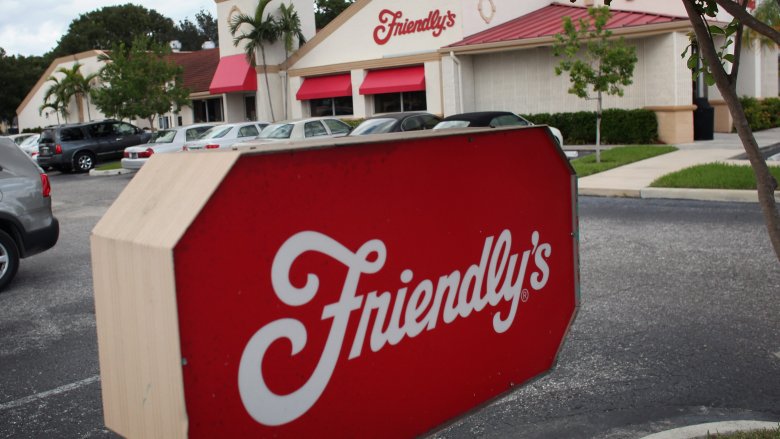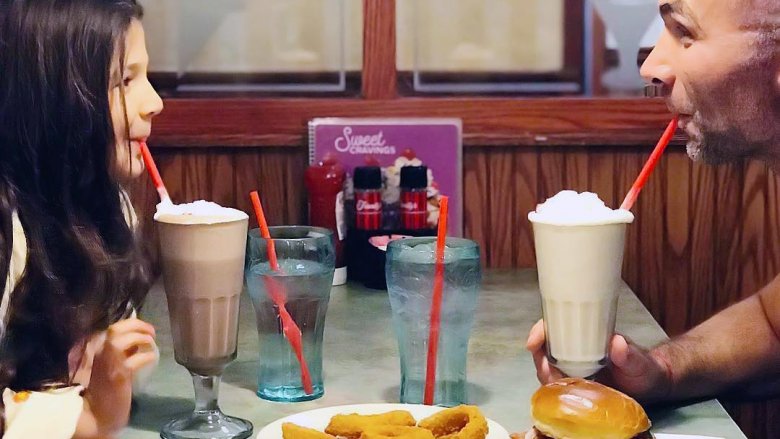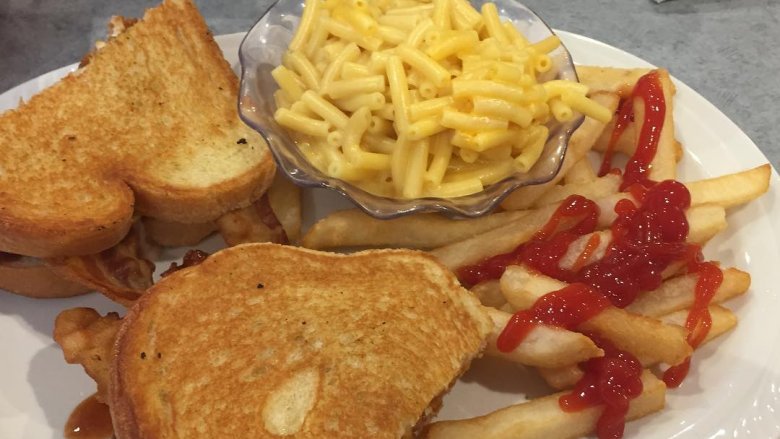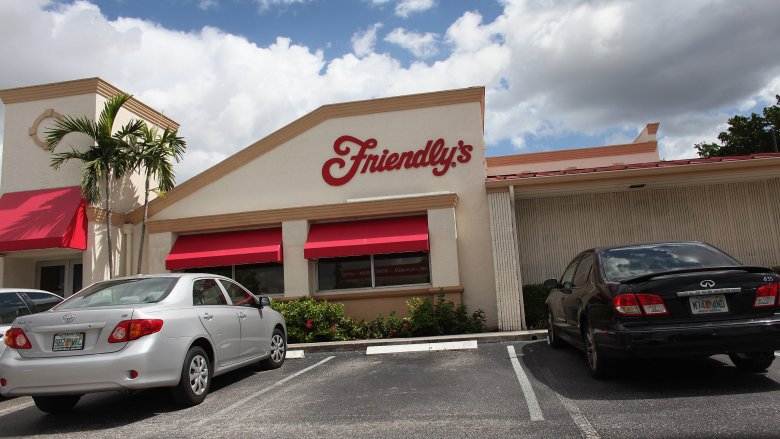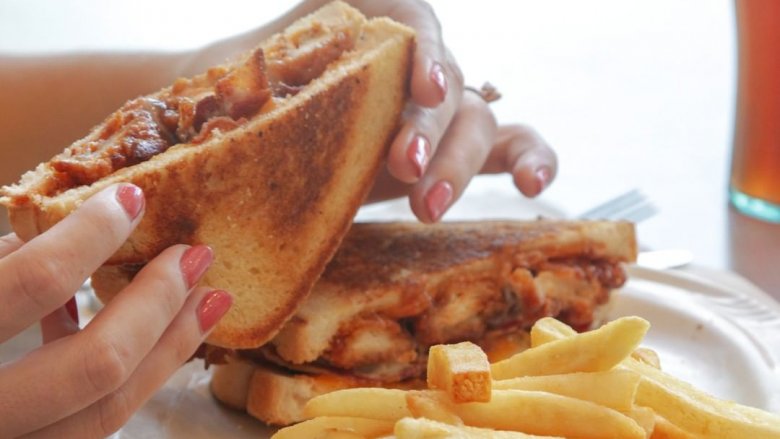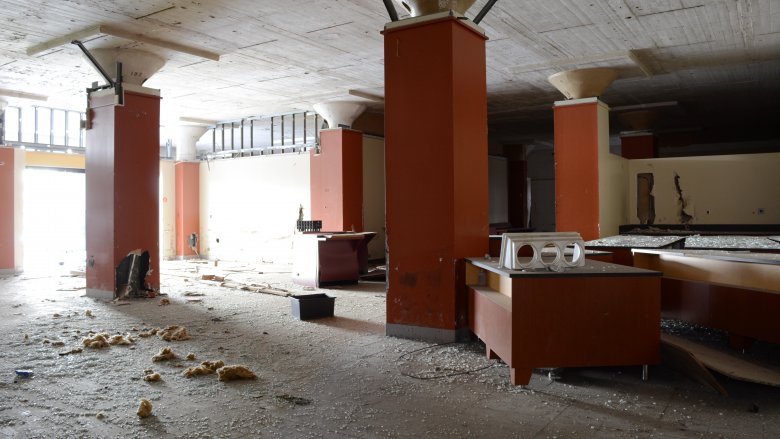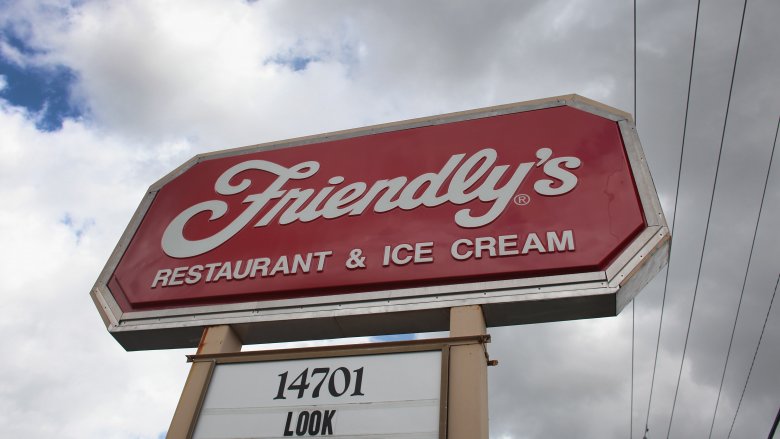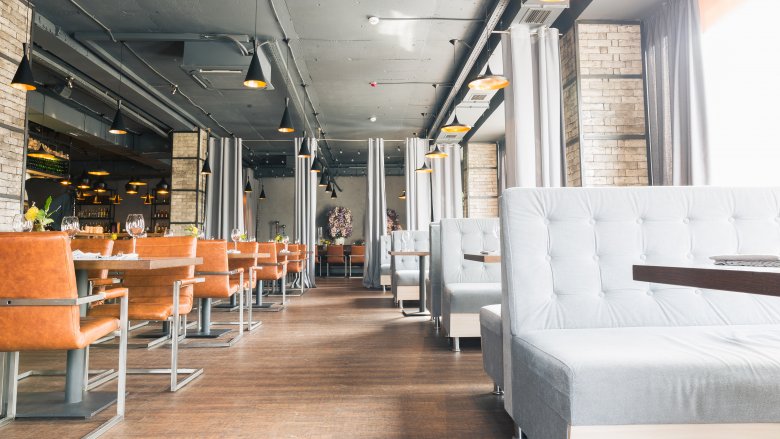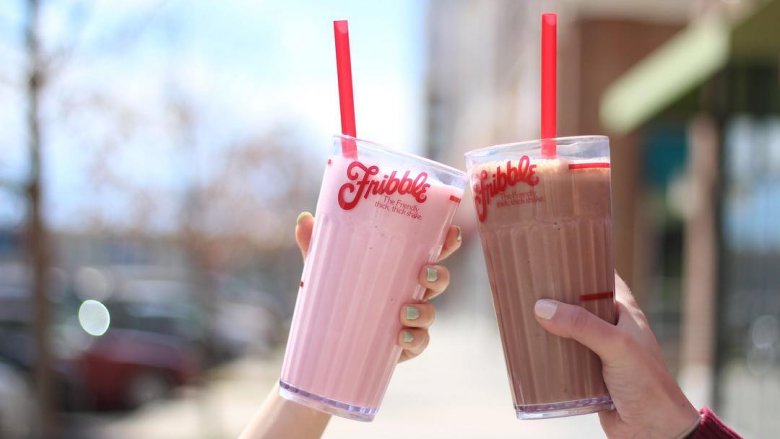The Real Reason Why Friendly's Are Disappearing
Since 1935, the Friendly's chain of family restaurants has been serving classic roadside Americana dishes including burgers, hot dogs, chicken fingers, comforting entrees, sandwiches, and yes, many, many dishes of the brand's iconic ice cream. But in recent years, Friendly's, originally conceived as "a friendly place for families to create lasting memories while enjoying handcrafted ice cream," has started to feel more like "a semi-abandoned space to watch kids with Kool-Aid stained lips grind frozen clam strips into the indoor/outdoor carpeting." The chain has been shuttering locations so quickly that you'd almost think there was a sale on store window-shaped pieces of plywood.
What's to blame for the rapid and steady demise of this suburban and interstate staple, and is there anything the company can do to pull itself out of financial free fall? We decided to take a look at the company's almost 85-year history, a road paved in hundreds of thousands of Fishamajig SuperMelts and Strawberry Fribbles, to figure out what went wrong.
Tension at the executive level caused a lot of instability
In spite of the chain's family-friendly image, the relationship between family members on Friendly's executive board has been anything but rosy.
In 2006, according to The Wall Street Journal, then-91-year-old co-founder S. Prestley Blake calmly walked to the podium during the corporation's annual meeting and, voice shaking, accused directors of "covering up" improper spending, including payments for a corporate jet by the company chairman. The other members of the board weren't impressed, interrupting him during his accusations, and even threatening to have him removed from the meeting.
The behind-the-scenes feuding hadn't improved much by 2007, when the still-disgruntled (then 92-year-old) Prestley Blake planned to join forces with the company's largest shareholder, Sardar Biglari, a 29-year-old Texas millionaire and son of an Iranian rug dealer, who was determined to work with Blake to seize more power and control over the restaurant. Prestley's younger brother Curtis intervened to try and talk some sense into his sibling, attempting to prevent control of the company from falling into the hands of Biglari, but the behind-the-scenes drama had already cast serious doubts about the company's future among investors.
In the end, Curtis just might have been right about Biglari. The Wall Street Journal reported in 2011 that when the restaurant chain was bought out by a private equity firm, Biglari cashed out and profited, (coincidentally, perhaps?) getting out before Friendly's filed for bankruptcy.
They consistently earn low marks for guest satisfaction and food quality
With all of the intrigue behind the scenes at the Friendly's corporation, it may be tempting to overlook the most obvious problem plaguing the struggling chain: It's just not very good.
In a 2017 brand loyalty survey of 126 fast food and restaurant chains by Nation's Restaurant News, Friendly's ranked at a dismal 106, with only 36 percent of customers saying that their last visit to the chain was motivated by the brand itself and not by convenience.
While this lack of consumer loyalty could be attributed to several factors, the easiest answer is probably the simplest: The food and service just don't score high marks with customers. Another survey revealed low scores in important areas such as value and food quality. Complaints abound regarding dirty restaurants, indifferent servers, slow service time, and burgers that seem to be assembled using whatever ingredients the kitchen happens to have around at the time, all adding up to a dining experience that most customers aren't anxious to repeat.
Prior to bankruptcy, the chain was hundreds of millions in debt
The financial struggle at Friendly's came to a head in late 2011, when the chain finally filed for Chapter 11 bankruptcy protection. At the time, the company maintained over 400 restaurants and employed around 10,000 people. Following this hard financial reset, optimism was high among executives at the restaurant chain. According to a press release issued in 2011, the company had secured approximately $70 million in new financing, which along with cash flow would "provide the working capital necessary to meet its ongoing obligations during the restructuring." The bankruptcy filing was designed to "provide Friendly's with the tools and time to strengthen its balance sheet, close underperforming restaurants, revisit certain agreements and reposition the company for long-term success."
A year later, when the company emerged from bankruptcy in 2012, it had closed over 100 stores, and bankruptcy proceedings had wiped away nearly $300 million dollars in debt, including pension plans for employees who had been promised a comfortable retirement.
Nearly a decade later, the chain continues closing locations nationwide. As of January 2019, there were 200 outposts of the restaurant still in operation, but that number keeps dwindling. As of April 2019, after closing another 23 stores, there are just 174 Friendly's left.
They're having trouble identifying a niche
It's hard to figure out exactly where Friendly's fits into today's food service landscape, and this difficulty finding a niche is spelling big trouble for the brand. When we visit a fast food restaurant, we can be pretty sure of what we're getting: So-so quality food served quickly and inexpensively. When we visit a full-service restaurant, we also know what we're getting: Better food served as part of an overall "experience" at the expense of time and the need to leave a tip.
Friendly's can't seem to figure out exactly where it wants to fit into this continuum. Many complaints are centered around the time it takes to receive a meal and the relative indifference of the staff, and these may be from customers who are more accustomed to the instant gratification of a fast food restaurant. The quality of the food served also doesn't appear to line up with the sit-down restaurant experience, which often means customers are ultimately served food that they could have gotten more quickly and less expensively elsewhere.
Friendly's is further blurring the lines between fast food and full-service restaurant with the rollout of limited-menu drive-through windows at many locations, which only serve to cause more confusion among consumers.
Chain restaurants in general are struggling
Part of the problem at Friendly's may have less to do with the questionable food, bad service, and financial mismanagement, and more to do with an overall larger trend among American consumers: We just don't want to go to chain restaurants as much anymore.
According to Restaurant Business Online in 2019, consumers in recent years are more interested in the unique experiences provided by independent restaurants and smaller chains, as opposed to the one-size-fits-all generic options offered by the larger chains.
This trend most dramatically affects midsized chain restaurants, since they lack the working capital needed to keep pace with investments and improvements in order to keep customers interested and coming back. Whereas a chain like McDonald's can simultaneously upgrade every restaurant in their system with things like improved drive-through technology, employee-free-ordering kiosks, revamped dining rooms, and menu upgrades, mid-range chains often end up left behind in the race to spend money. Smaller, independent restaurants focus on the unique value of their service and offerings, and don't get as caught in this competitive capital-crunch.
The American middle class is shrinking
For years, the chain restaurant has been the staple grazing ground of the American middle class; a place where you could take the family out for a night on the town, each order a steak topped with shrimp, cream sauce, or shrimp and cream sauce, served alongside a baked potato as big as your head and fortified with unlimited trips to a salad bar soaked with Thousand Island dressing and imitation bacon bits. Thanks to chain restaurants, even a moderately financially stable family could have a reasonably good experience without breaking the food budget for a month.
The problem may be that these types of restaurants, like Friendly's, have fallen out of favor, or that negative online reviews have pulled back the veil on the quality of these establishments. Or, it could be something potentially much scarier and harder to pin down — middle-class chain restaurants may be disappearing because the middle class itself is vanishing. Customers at both ends of the economic spectrum are still going out to eat, but they're eating cheaper food at McDonald's, or lavish meals at the neighborhood farm-to-table restaurant run by the celebrity chef. Everything in the middle is rapidly disappearing.
Commodity costs are on the rise
At a certain point, it doesn't matter how well your restaurants are doing, how much people love your food, or how popular your brand is; when the prices on ingredients critical to your operation such as cream and sugar (y'know, the things ice cream are made of) or corn and wheat start to rise, it puts budget chains like Friendly's in a real bind.
In order to combat rising commodity costs, restaurants can ordinarily either raise prices or reduce portion sizes. Neither of these options seem like a good match for Friendly's; you can't raise prices when sales have been steadily declining for years, and the families and senior citizens that make up the Friendly's customer base are likely to balk at a perceived reduction in portion sizes. Instead, Friendly's continues closing "underperforming" restaurants, in an effort to stabilize the locations that manage to still exist.
Consumer preferences are changing
Think about the last time you heard a good friend or family member really raving about a recent meal they had out at a restaurant. They probably raved about how all of the ingredients came from local purveyors, were cooked perfectly, or were arranged by an incredible chef into an artful, Instagram-ready plate that was as pleasing to the eye as it was to the stomach. Maybe it was a gorgeously designed restaurant space, filled with industrial lighting and reclaimed wood and polished concrete and packed to the brim with well-dressed, attractive singles anxious to meet new people. Or maybe the food was so over-the-top on the creativity scale that your friend was left explaining over and over again how he'd just never thought anyone could ever combine potatoes, beef tallow, and chimichurri in quite that way.
Whatever it is you absolutely love about your favorite restaurant, it's hard to figure out how Friendly's can possibly hope to compete, with their soggy, uninspired grilled cheese sandwiches and wonky clown cones. Friendly's management acknowledges this, blaming "shifting consumer preferences" and "geographic areas that have changed dramatically" since the restaurants first opened... but they don't seem to know how to keep up.
Their time may simply have come and gone
So far, we've examined a few hard-and-fast, concrete reasons for Friendly's continued struggles. But there may be a much more nebulous, hard-to-pin-down reason for Friendly's sagging sales: Their time may simply be up, according to some analysts.
"Restaurants have a life cycle, and Friendly's has hit it,” said industry analyst Ron Paul, president of Technomic Inc. "I don't think there is any marketing fix when you are a model of a restaurant that went out of style.”
Restaurants open and close every day, often with an initial surge of excitement, the initial ramp-up to profitability, success, acclaim, and expansion, followed often by the slow decline and ambivalence of owners and staff. More attention gets paid to the restaurant's bottom line than to the experience of customers, and as a result, fewer and fewer come each year.
Friendly's was founded on a wholesome concept: Affordable, approachable food for the whole family, that always ends in an ice cream sundae. For better or for worse, this may be a concept that has run its course.
